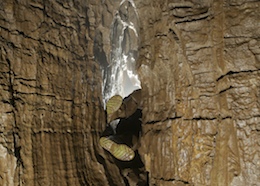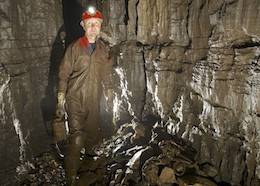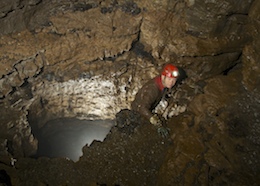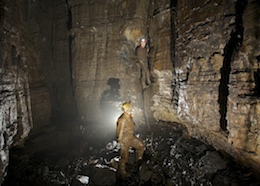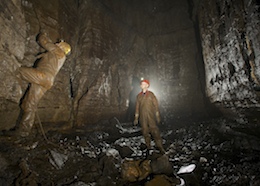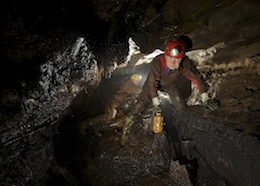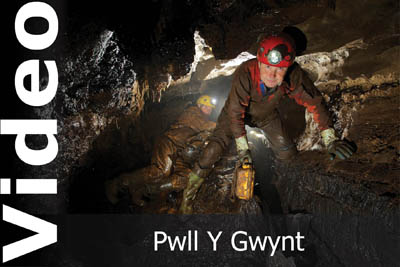Overview
This hard to find and difficult to access cave is formed from a series of tall avens that are linked by tight rifts and low muddy crawls. The extreme location, muddy tight passages and sharp rock make this cave a little visited collector's item.Length 260m
Altitude 465m
Grid Reference SO 18804 15681
History
Walking off a hangover on the afternoon of Saturday 14th March 1981, Trevor Knief headed up the gully above Agen Allwedd after seeing a party off into the cave. Heading along the escarpment at high level he looked for a place to sit and admire the view. Finding a small ledge at the top of a gully he lit a cigarette and was amazed to see the ash blowing away on such a still day. A rabbit sized hole provided a strong draught and digging with his hands he enlarged it enough to see it would be worth retuning to dig. During the Summer of 1981 the cave was dug, explored and surveyed, with the water dye tested to an area below Keyhole Chamber in Agen Allwedd.
Location
The cave is located 90m above the tramroad very close to the cliff at the top of the Escarpment. The tramroad should be followed from Whitewalls past Eglwys Faen to a point where a scree slope can be followed upwards before the cliff that holds Agen Allwedd is reached. Following the slope upwards and veering to the right brings you above the cliff face that the entrance to Agen Allwedd is located in. Above this cliff is a scree slope and the edge of the scree should be followed upwards until the apex of the scree slope is reached at the base of a prominent gully. The gully has a 1-2m wide rocky base with grass banks rising from both sides. The gully should be followed upwards towards the cliff at the top of the escarpment. Near the to top, the grass covered banks at each side of the gully rise higher and steeper. At the top of the gully a tree is found and the grass bank at the right of the gully should be climbed. Towards the top of the bank, but before the cliff is reached is a small outcrop of rock. The entrance is located under the rock on a small grass ledge. The entrance can only be seen when you are right beside it.
Llangattock Google map showing the location of Pwll Y Gwynt and other caves in the area.
Location map - click marker to show entrance photo
Access
The cave is not covered by any access controls, bar those provided by mother nature. The difficult ascent to the cave entrance combined with the difficulty in locating it deter most visitors.
Description
Entering the body sized entrance tube leads directly to the top of the first pitch. The pitch, which is quite rift-like at the top has two scaffold bars to provide belays. The second bar providing the best hang for the 21m deep pitch. A small ledge allows a traverse out to the second bar to make the descent. When descending the pitch a large ledge is found half way down and below this the rift opens out into a more circular pot some 2-3m diameter. From the bottom of the pitch the First Aven is reached, where a passage can be followed back under the entrance pitch heading for the surface before it chokes. The way on is a tight squeeze through a rift to enter the Second Aven 2m from floor level. From the Second Aven the way on is a 10m crawl that leads to a ledge some 5m above the floor of the Third Aven. The aven can be descended to give access to the "Quick Way" please note the quotation marks! The main way on from the Third Aven is to follow the ledge to the left where a short crawl and climb up leads to a rift passage and then a 5m climb down a knotted rope to enter the large and impressive Fourth Aven. This aven has been climbed at both ends, a rope still hangs from the southern side of the chamber, but the way on is a low crawl that leads off from the opposite side of the climb down into the aven. From this point the cave becomes progressively muddier with some flat out crawls in very sticky mud. The crawl starts quite pleasant, first dropping down a small pot before becoming lower and a T junction is reached, that closes down to the right, the way on is to the left. Soon a drop down leads to a short section of walking passage before a climb up and squeeze through calcite bosses at the top leads to a low muddy crawl. Ahead a junction is reached where the passage closes down both to the right and to the left. The way on is a passage on the left before the junction is reached. This cosy muddy crawl heads upwards until a tight squeeze over a calcite floor enters a larger section of passage with a small inlet of water from above. Ahead the passage reaches a second inlet from above where a 3m climb up enters the Fifth Aven. Here an old 12m rope hangs down to assist the ascent of the first caver in the group, who can then rig the pitch. At the top a ledge is reached with three crawls leading off. Two of the crawls silt up very quickly, while the third reaches the Sixth Aven via a small tube. An 8m descent with awkward take off leads to the floor of the Sixth Aven. Here a passage leads to a low wet crawl to reach a small chamber where another wet crawl leads to a sand and cobble dig.Back at the climb up to the Fifth Aven, the passage below can be followed straight ahead over mud covered slabs to reach a junction. To the right the passage closes down round a corner, while to the left is the other end of the "Quick Way" that leads back to the bottom of the Third Aven.
Tackle
Pitch 1 21m (belay from two scaffold bars)Fifth Aven 12m (in-situ rope best re rigged after the first person climbs up.)
Sixth Aven 8m
References
Cambrian Cave Registry entry for Pwll Y GwyntCaves of South Wales | Tim Stratford | ISBN: 1-871890-03-9 | Published by Cordee
A Caver's View of the Clydach River | Theo Schuurmans | Cwmbran Caving Club
Descent 48 | p18 | Trevor Knief | A brief note on the discovery
Descent 49 | p41 | Chelsea SS | Survey
An Exploration Journal of Llangattwg Mountain | Chelsea Spelaeological Society Records V19 - 1992
Video
Warnings
The main belay bar (November 2013) on the entrance pitch is very corroded and starting to deform under load.The ascent up the escarpment is incredibly steep and the route to the entrance heads above a cliff face that overlooks the tramroad. A slip on the way to or from the cave could lead to a very long fall.
Disclaimer
The photographs and information of this page has been provided to help cavers planning trips. Caving can be a dangerous activity, if you are interested in exploring caves please join a caving club so you can enjoy a safe introduction to this sport. Local caving clubs are listed on the links page or you can visit the 'New To Caving' website for more options.If you feel that any of the information is incorrect or should be updated please contact us.


